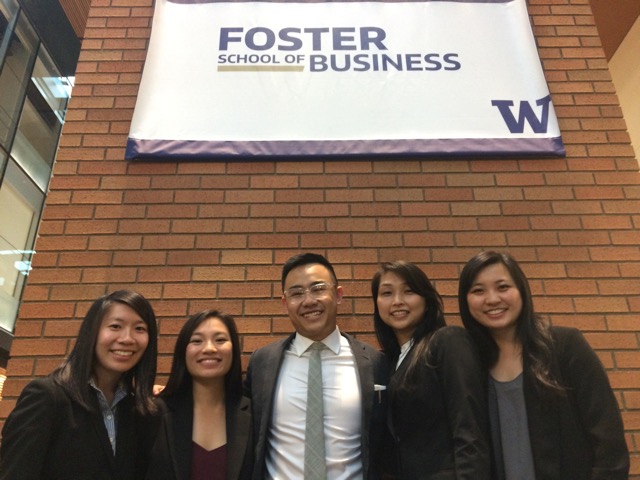Brooks Running towards a vision: to become the most loved running shoe
 Lace up your (Brooks) running shoes, put on your technical quick-dry shirt and get ready to run into the future for Seattle-based Brooks Running.
Lace up your (Brooks) running shoes, put on your technical quick-dry shirt and get ready to run into the future for Seattle-based Brooks Running.
According to Brooks Running’s business principles: “we do one thing and we do it better than anyone else on the planet….behind every employee, every idea, and every lace or stitch of gear is a razor-sharp focus on runners and the running experience. That’s it.” The entire company has a passionate for running, runners and the ways in which they can make running experiences better. Can this singular focus on all things running-related make the company the most loved running shoe in the industry – while moving towards the goal of doubling revenues to $1billion by 2020?
This was the challenge 52 teams of students addressed during the Foster School of Business’ capstone Strategy Development Case Competition.
Brooks is a well-known and respected brand among “self-defined” runners – those who run 50 or more times per year. 43% of their core customer profile is between the ages of 25 and 44 years. Brooks resonates particularly well with those who have suffered a running related injury. The company’s R&D has focused on creating the most bio-mechanically sound running shoe, helping athletes who have been previously sidelined by a case of runner’s knee.
With this strong current customer profile, clear gaps emerged for the teams to concentrate on: how to attract more Millennials to the brand and how increase the base of “self-defined” runners. Beyond that, Brooks holds just 14% of total market share. The recommendations needed to focus on how to capture a more significant piece of this pie.
A key differentiator for Brooks is its corporate culture and brand ethos. It’s “Run Happy” moto inspires both the serious runner as well as having the potential to connect with all people who run at some point during a given year.
For Coleman Brown, Director of HR, the opportunity to partner with the Foster School on this case competition was an exciting one. “Focusing on expanding the millennial market is a critical priority for the company. Having nearly 200 students bring their fresh perspectives to help us discover solutions to this issue was helpful. Plus, I understand we may have won over a few new customers!”
The University of Washington students were extremely professional in all that they did. From their presentation materials to their speeches, their preparedness to their demeanor, we were blown away by how put together each and every one of them was and how much their professionalism aided their overall projects.
Competition day arrives and the halls and classrooms of PACCAR and Dempsey Halls are filled with excited energy, anticipation and often a fair share of nervousness as teams pitch their ideas to friends and alumni of the business school as well as representatives of Brooks. Annice Wong, a member of the winning team noted that “the judges’ comments were really valuable….They allowed us to think further about our solution, and we were able to address their concerns in later rounds.”
Solutions on how to make Brooks the most loved running shoe brand ranged from virtual reality games to test the product to creating running communities and developing integrated social media strategies including a social media contest with winners traveling globally to run the trails of the world. Ultimately the winning strategy was presented by: Josh Chinn, Esther Lee, Christina Nguyen, Sang-Young Sien, Hei Yu (Annice) Wong. Their “big idea” was to create small concept stores in targeted cities complete with tread mills where customers test –run shoes and place orders for 2-day delivery.
What was behind their solution? “My team’s idea (was inspired by)…what’s happening in the market and how it can be applied to Brooks” said Josh Chinn. Christina Nguyen offered that their team was willing to “take risks and be bold (with) their ideas, because there’s never a right solution.”
The solution did just that for senior leaders at Brooks judging the final round presentations. “The University of Washington students were extremely professional in all that they did. From their presentation materials to their speeches, their preparedness to their demeanor, we were blown away by how put together each and every one of them was and how much their professionalism aided their overall projects. We all left impressed by the Foster School of Business’ students and their work.”
The winning team was indeed running happy as they cruised to the Fremont-based flagship store to get fitted for new running shoes as a thank you from VP of Sales, Mike Billish and the company.
Developing the case and organizing the competition is a collaborative effort! Many thanks to Paul Frogley, Director of Corporate Relations for connecting us with Brooks; Rick McPherson, faculty course coordinator; Sadie Raney MBA Alumna and case writer extraordinaire; Clay Schwenn for coordinating judges and logistics for the competition; all of the friends, alumni and representatives from Brooks who serve as judges; and Natalie Goode and Coleman Brown from Brooks for your willingness to partner with the Foster School.
